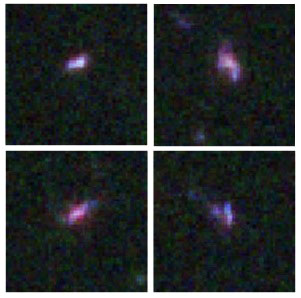About a decade ago, astronomers began to realize that nearly all massive nearby galaxies have supermassive black holes in their centers. Strangely, the mass of this enormous black hole is well-correlated with the total mass of the collection of stars in the inner part of the galaxy: this inner galaxy structure, called the galaxy bulge, is always about 500 times as massive as the supermassive black hole. That is, a galaxy bulge with a mass equal to a billion Suns will have a supermassive black hole with a mass of two million times the mass of the sun.
Both galaxy bulges and supermassive black holes grow with time. Galaxy bulges build up mass by forming stars and merging with other galaxies, and black holes grow in "active galactic nuclei (AGN)" phases by accreting gas, dust, and stars within their event horizons. In order to maintain the observed correlation between their masses, galaxies and their black holes must grow together, with the galaxy bulge always growing around 500 times faster than the black hole. Somehow the black hole and the galaxy "know" about one another as they both grow.
This leads to an interesting "chicken or egg" question: which comes first, the galaxy or the black hole? Do tiny young galaxies in the distant past already have growing black holes? Or is the close link between galaxies and their black holes only a recent development?
 |
Four examples of adolescent, low-mass galaxies in
CANDELS which host growing AGNs. Image credit:
A. Koekemoer, Space Telescope Science Institute |
To find the black holes, we had to combine the deep CANDELS imaging with the unique HST infrared grism spectroscopy in the same field. The HST grism is unique because it provides both spectral information and spatial data. So the grism not only disperses the light from a galaxy into a spectral rainbow, but it also allows us to compare an inner galaxy spectrum with the outer spectrum of the same galaxy. This is particularly useful for finding AGNs, which tend to strongly affect the interior of a galaxy without changing the outer region too much.
Accretion onto a black hole produces much more UV and X-ray emission than typical galaxy starlight. High-energy photons are very efficient at ionizing atoms, producing a tell-tale emission line signature in a spectrum. Because AGNs live in the centers of galaxies, they cause a markedly different ionization signature in a galaxy's interior compared to its outer region -- and the CANDELS grism data revealed this very feature in several distant and low-mass galaxies.
Accretion onto a black hole produces much more UV and X-ray emission than typical galaxy starlight. High-energy photons are very efficient at ionizing atoms, producing a tell-tale emission line signature in a spectrum. Because AGNs live in the centers of galaxies, they cause a markedly different ionization signature in a galaxy's interior compared to its outer region -- and the CANDELS grism data revealed this very feature in several distant and low-mass galaxies.
Four examples of these teenage galaxies with growing black holes are shown in the graphic above. As you can see, they look like barely-detected smudgy little disks. They are particularly interesting because they don't seem to have the bulge structure seen in the centers of local galaxies with growing AGNs. It seems that we've determined that the black hole "egg" actually comes before the galaxy bulge "chicken!" And it's a testament to the tremendously deep CANDELS imaging and spectroscopy that we can learn about growing black holes in such faint teenage galaxies.
No comments:
Post a Comment